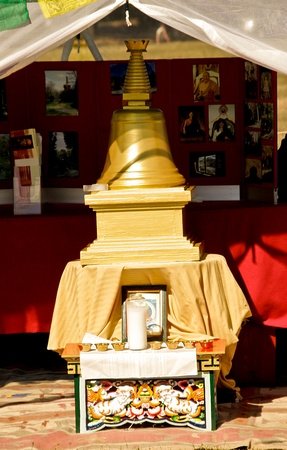0675: Tibetan Buddhist Stupa, Kunzang Palyul Choling (KPC) Temple
A Stupa, or “Chorten” in Tibetan, which means"the basis of offering", can be described as a “Spiritual Monument”. Itis a symbol of enlightened mind, (the awakened mind, universaldivinity) and the path to its realization. The stupa represents theBuddha's body, his speech and his mind, but most especially his mindand every part shows the path to Enlightenment.
"Thevisual impact of the stupa on the observer brings a direct experienceof inherent wakefulness and dignity. Stupas continue to be builtbecause of their ability to liberate one simply upon seeing theirstructure" - Chogyam Trungpa Rinpoche
Every stupa contains at the very least a life tree and holy relics:
"Whena great teacher passes away, his body is no more, but to indicate thathis mind is dwelling forever in an unchanging way in the dharmakaya,one will erect a stupa as a symbol of the mind of the buddhas" - HHDilgo Khyentse Rinpoche
Shakyamuni,the historical Buddha, had instructed his disciples that after hispassing, his body should be cremated and the remains enshrined in areliquary monument, or Stupa, as was the custom with regardto the great leaders of the past in India. His purpose for having suchmonuments erected was not self-aggrandizement but, in the words of thelate Lama Govinda, "to remind later generations of the great pioneersof humanity and inspire them to follow their example, to encourage themin their own struggle for liberation from suffering."
When the Buddha's body had been cremated, a dispute arose over whom theremains should belong to, and who, therefore, should have the honor ofbuilding the Stupa. A Brahmin named Done interceded in this quarrel andsuggested that the remains be divided amongst several parties. Thedecision was accepted, and as a result eight Stupas were built indifferent kingdoms of India.
The eightfold division is echoed in the eight types of design stillused in Tibetan traditions for the construction of Stupas that enshrinethe relics of great teachers. The designs commemorate the eight majorevents in the life of Shakyamuni, that of his birth, enlightenment,turning of the wheel of Dharma, descent from a heavenly realm,performing of miracles, reconciliation of a split in the Sangha atBamboo Grove, voluntary prolonging of his life at Vaishali, and hispassing away at Kushinagar.
AStupa is more, however, than a mere reliquary monument. It is anabstract image of the state of Enlightenment attainable by all beings,and the symbolism of this architectural image operates on severaldifferent levels simultaneously. On what we may call the level ofarchetypes, a Stupa incorporates five different geometric shapespertaining to the five elements of earth, water, fire, air and space,from which the world and all its atoms are composed. Furthermore, theoverall shape of a Stupa bears a close resemblance to the shape of aseated Buddha. Merely by viewing such harmoniously balanced images wereceive subtle benefit, experienced as a feeling of peace, well-beingand wholeness. The various levels of a Stupa also correspond to thevarious levels on the spiritual path culminating in full Enlightenment.
Stupasalso serve as focal points for the widely followed practices ofcircumambulation and making offerings of light, which are said tocreate merit, or virtuous karma towards Enlightenment. It is comm


